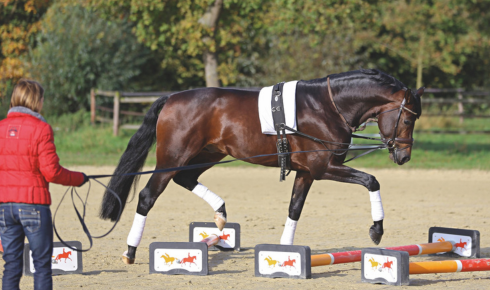Key Takeaways:
- Cavaletti exercises enhance a horse’s balance, coordination, and muscle strength, making them suitable for horses at every level.
- They can effectively improve gaits, rhythm, and jumping technique, offering benefits across multiple equestrian disciplines.
- Proper setup and safety considerations are vital for ensuring effective training and the horse’s well-being.
Table of Contents:
- Enhancing Gaits and Rhythm
- Improving Jumping Technique
- Building Muscle and Flexibility
- Safety Considerations
- Incorporating Cavaletti into Training Routines
Cavaletti, originally developed by renowned Italian cavalry officer Federico Caprilli, are now considered one of the most valuable and versatile pieces of training equipment in the equestrian world. Their design is deceptively simple: a series of wooden or synthetic poles that can be raised on specially designed supports or left on the ground. This flexibility allows for a nearly unlimited array of creative exercises to develop a horse’s strength, agility, and coordination. Their adjustability makes them especially appealing to trainers and riders who want to customize workouts for horses of any age, fitness level, or discipline. For those looking to invest in reliable and adaptable equipment, Cavaletti horse jumps are available in a variety of materials and configurations from reputable suppliers.
Whether your goals involve preparing a young horse for its first show season, maintaining the athleticism of a seasoned jumper, or providing safe conditioning for a horse in recovery, cavaletti offer proven, practical benefits. Not limited by discipline, these training aids are equally useful in dressage, show jumping, eventing, and even western riding or trail work. By starting with high-quality, purpose-built cavaletti—designed with safety and durability in mind—riders can maximize both performance results and their horse’s long-term health.
Enhancing Gaits and Rhythm
One of the most compelling reasons to use cavaletti is their unmatched ability to improve the quality of a horse’s gaits while establishing a clear, reliable rhythm. When poles are set up thoughtfully on the ground, they provide invaluable visual and physical feedback to the horse. This structure guides the animal toward more deliberate, evenly spaced steps, which is particularly beneficial for young horses still learning to balance under saddle or older horses who may have developed inconsistent movement patterns over time. Through regular cavaletti work, even horses prone to pacing or losing rhythm develop a better sense of timing and fluidity, leading to expressive and consistent gaits in all work.
Customizing Stride Length and Tempo
With the flexibility of adjusting the distance between poles, trainers and riders can tailor each session according to specific goals. For instance, positioning the poles closer together encourages a horse to slow down and take shorter, more controlled steps. This is incredibly effective for horses that tend to rush their gaits or trip over their own feet. By gradually widening the distance, riders can train their horses to reach forward and lengthen the stride, which is essential for tests or patterns requiring elasticity and ground cover, such as those seen in upper-level dressage.
Improving Jumping Technique
Cavaletti exercises are a non-intimidating and highly effective way to advance a horse’s jumping form and technical understanding. Unlike standard jumps, cavaletti present low-stress scenarios where horses can concentrate on correct posture and careful placement of their feet. Arranging a series of low cavaletti leading up to and away from a jump serves dual functions: it reins in the approach so that both horse and rider arrive at the fence in balance, and it reinforces the horse’s focus on both takeoff and landing. Over time, this thoughtful sequence builds a foundation of confidence, teaching horses to remain attentive and composed as they encounter more complex or higher obstacles.
Building Rhythm and Judgement
The benefit of using cavaletti in a grid before a jump is especially pronounced. Uniform spacing encourages the horse to maintain a steady tempo, eliminating last-second changes in speed or direction that could lead to awkward launches or refusals. As the horse becomes accustomed to the predictability of the poles, it naturally develops better judgment about where, how, and when to lift off the ground. Not only does this improve jumping accuracy, but it also promotes a rounded bascule—the ideal arched shape of the horse’s back over a jump.
Building Muscle and Flexibility
Traversing cavaletti at various heights and configurations is an exceptional way to activate key muscle groups and encourage stretching in ways that plain flatwork cannot always provide. As horses raise their legs to clear each obstacle, they must engage the chest and shoulder muscles and the core and powerful hindquarters. This combination of lifting, stretching, and controlled movement is particularly important for young horses, still developing their musculature, and for horses returning from injury, since it avoids the concussive impact of hard jumps.
Gradual Conditioning for All Levels
Introducing cavaletti work should always start with poles on the ground. As the horse grows stronger and more confident, the poles can be gradually raised in small increments. This approach ensures continuous muscle development without risking overuse or fatigue. Consistently working over cavaletti at both walk and trot, and from multiple directions, helps increase flexibility through the back and hips by encouraging the horse to stretch and round its topline. Over time, this kind of conditioning builds the muscle groups necessary for a strong topline and effective engagement of the hindquarters, promoting long-term soundness and athletic versatility.
Safety Considerations
Safety remains the single most important factor when utilizing cavaletti in training routines. All poles and supports should be checked regularly for signs of wear, such as cracks, sharp edges, or splinters that could injure the horse. Only use materials and designs intended for equine use, as improvised or substandard equipment increases the risk of accidents. Always start new exercises at the lowest and safest settings so the horse can get acclimatized to the demands of the activity.
Proper Supervision and Gradual Progression
Introducing cavaletti should be gradual, with careful attention given to the horse’s confidence and comfort level. Early sessions must be kept short and positive, increasing duration and difficulty as the horse becomes more skilled and fit. Supervision by an experienced trainer or knowledgeable horseperson ensures that mistakes are quickly corrected, preventing the development of bad habits. Watch closely for signs of mental or physical fatigue, and scale back the intensity if the horse struggles. This proactive approach to safety allows for steady, sustainable improvement while preventing injuries and setbacks.
Incorporating Cavaletti into Training Routines
Cavaletti are among the most versatile training tools available, seamlessly integrating into groundwork, lunging, and ridden work. Ground poles can be used at the most basic level for practicing in-hand manners, encouraging careful stepping and attentiveness without a rider’s weight. When lunging, they help reinforce balance and rhythm by requiring the horse to self-regulate its pace and stride without direct rein or leg cues. Under saddle, cavaletti work enhances stride control, responsiveness to aids, and overall engagement over various gaits and patterns.
For maximum results, riders and trainers should vary both the pattern and layout of the poles within a session. Creativity—such as arranging poles in a fan shape, on a circle, or using alternating heights—keeps sessions interesting and mentally stimulating. This diversity holds the horse’s attention and exposes it to new challenges that develop comprehensive athleticism

